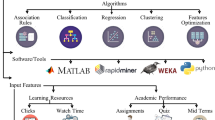Abstract
Student academic performance (SAP) is one of the most important factors that influence the attainment of an educational institution. Educational data mining (EDM) follows the principle of the data mining process that can be applied to educational data to analyze the student’s academic performance. In this paper, a student’s performance prediction model is proposed that includes new features such as the grade of the students and backlog information which is identified as the most important features based on the data mining method. In this study, we train and build models on a small size dataset and provide the feasibility of creating a prediction model which gives a satisfying accuracy rate. We also find the key attributes such as subject backlog, subject grade pay average which are essential for building models and visualization of data. The key attributes are fed into different algorithms to find the best model. The efficiency of the proposed model is calculated using different classifiers such as decision tree, k-nearest neighbor (KNN), and support vector machine (SVM). Furthermore, to enhance the performance of the classifier techniques, the ensemble methods like bagging, boosting are applied. The outcome of this study proves that there exists a direct correlation between the grades and their academic performance. The outcome of the study proves the efficiency of ensembled methods by providing an accuracy of 88.3%.
Access this chapter
Tax calculation will be finalised at checkout
Purchases are for personal use only
Similar content being viewed by others
References
Amrieh EA, Hamtini T, Aljarah I (2015) IEEE Jordan conference on applied electrical engineering and computing technologies (AEECT), pp 1–5
Hanna M (2004) Data mining in the e-learning domain. Campus-Wide Inf Syst 21(1):29–34
Costa EB et al (2017) Evaluating the effectiveness of educational data mining techniques for early prediction of students’ academic failure in introductory. Comput Hum Behav 73:247–256
Romero C, Ventura S (2007) Educational data mining: a survey from 1995 to 2005. Expert Syst Appl 33(1):135–146
Trstenjak B, Dženana (2014) Determining the impact of demographic features in predicting student success in Croatia. In: 2014 IEEE international conference on information and communication technology, electronics and microelectronics (MIPRO 2014), pp 1222–1227
Zorrilla ME, Menasalvas E, Marin D, Mora E, Segovia J (2005) Web usage mining project for improving web-based learning sites. In: Computer aided systems theory–EUROCAST 2005, Springer, Berlin, pp 205–210
Shahiri, A.M., Husain, W.: A review on predicting student’s performance using data mining techniques. Proc Comput Sci 72, 414–422 (2015)
Gunuc S, Kuzu A (2015) Student engagement scale: development, reliability, and validity. Assessm Eval Higher Educ 40(4):587–610
Suen CY et al (2000) Multiple classifier combination methodologies for different output levels. In: First international workshop on multiple classifier systems, pp 52–66
Sabzevari M et al (2018) Cornell Uni. arXiv preprint arXiv:1802.07877
Ajibade S-SM, Ahmad NBB, Shamsuddin SM (2019) A novel hybrid approach of Adaboostm2 algorithm and differential evolution for prediction of student performance. IJSTR 8(7)
Verma C, Stoffova V et al (2020) Machine learning-based student native place identification for real-time. IEEE Access 8:130840–130854
Author information
Authors and Affiliations
Editor information
Editors and Affiliations
Rights and permissions
Copyright information
© 2022 The Author(s), under exclusive license to Springer Nature Singapore Pte Ltd.
About this paper
Cite this paper
Vaheed, S., Pratap Singh, R., Nayak, P., Mallikarjuna Rao, C. (2022). Student’s Academic Performance Prediction Using Ensemble Methods Through Educational Data Mining. In: Bhateja, V., Satapathy, S.C., Travieso-Gonzalez, C.M., Adilakshmi, T. (eds) Smart Intelligent Computing and Applications, Volume 1. Smart Innovation, Systems and Technologies, vol 282. Springer, Singapore. https://doi.org/10.1007/978-981-16-9669-5_20
Download citation
DOI: https://doi.org/10.1007/978-981-16-9669-5_20
Published:
Publisher Name: Springer, Singapore
Print ISBN: 978-981-16-9668-8
Online ISBN: 978-981-16-9669-5
eBook Packages: Intelligent Technologies and RoboticsIntelligent Technologies and Robotics (R0)




